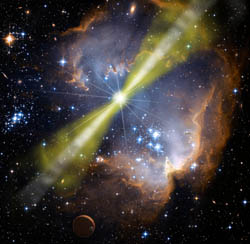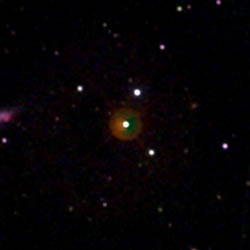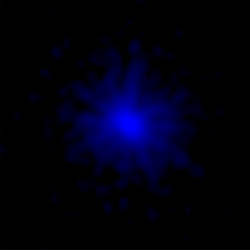Imagine the Universe News - 10 September 2008
"Naked-Eye" Gamma-ray Burst Was Aimed Squarely at Earth
| 10 September 2008 |
Unparalleled data from satellites and observatories around the globe show that the jet from a powerful stellar explosion March 19 was aimed almost directly at Earth. The event, called a gamma-ray burst, became bright enough for human eyes to see. The observations give astronomers the most detailed portrait of a burst ever made.
NASA's Swift satellite detected the explosion -- formally called GRB 080319B -- at 2:13 a.m. EDT that morning and pinpointed its position in the constellation Boötes. "Swift was designed to find unusual bursts," says Swift principal investigator Neil Gehrels at NASA's Goddard Space Flight Center in Greenbelt, Md. "We really hit the jackpot with this one."
In a paper to appear in September 11, 2008 issue of Nature, Judith Racusin of Penn State University in University Park, Pa., and a team of 92 coauthors report observations across the spectrum that began 30 minutes before the explosion and followed its afterglow for months. The team concludes that the burst's extraordinary brightness arose from a jet that shot material directly toward Earth at 99.99995 percent the speed of light.
At the same moment Swift saw the burst, the Russian KONUS detector on NASA's Wind satellite also sensed the gamma rays and provided a wide view of their spectral structure. Simultaneously, a robotic wide-field optical camera called "Pi of the Sky" in Chile captured the burst's first visible light. The system is operated by a group of institutions from Poland.
Within the next 15 seconds, the burst brightened enough to be visible in a dark sky to human eyes. It briefly crested at magnitude 5.3 on the astronomical brightness scale. Incredibly, the dying star was 7.5 billion light-years away.
| This animation shows how astronomers think GRB 080319B erupted. A narrow, ultrafast jet first punches through the star and is followed by a wider, less energetic jet. Credit: NASA/Swift/Cruz deWilde (Video Description) |
Telescopes around the world were already studying the afterglow of another burst when GRB 080319B exploded just 10 degrees away. TORTORA, a robotic wide-field optical camera operated in Chile by a Russian-Italian collaboration, also caught the early light.
TORTORA's rapid imaging provides the most detailed look yet at visible light associated with a GRB's initial gamma-ray blast. "We've been waiting a long time for this one," says TORTORA senior scientist Grigory Beskin of Russia's Special Astrophysical Observatory.
Both Swift's UltraViolet and Optical Telescope and X-Ray Telescope indicated they were effectively blinded. "At first, I thought something was wrong," Racusin recalls. Within minutes, as reports from other observers arrived, it was clear this was a special event.
Gamma-ray bursts are the universe's most luminous explosions. Most occur when massive stars run out of nuclear fuel. As a star's core collapses, it creates a black hole or neutron star that, through processes not fully understood, drive powerful gas jets outward. These jets punch through the collapsing star. As the jets shoot into space, they strike gas previously shed by the star and heat it, which generates bright afterglows.
The team believes the jet directed toward Earth contained an ultra-fast component just 0.4 degree across. This core resided within a slightly less energetic jet about 20 times wider.
The broad component is more typical of what Swift sees from other bursts. Perhaps every gamma-ray burst has a narrow jet, but astronomers miss it most of the time. The nearly head-on alignment required to see it occurs by chance only about once a decade.
Swift is managed by NASA's Goddard Space Flight Center. It was built and is being operated in collaboration with Penn State, the Los Alamos National Laboratory, and General Dynamics in the U.S.; the University of Leicester and Mullard Space Sciences Laboratory in the United Kingdom; Brera Observatory and the Italian Space Agency in Italy; plus partners in Germany and Japan.
The TORTORA camera is mounted on the Italian REM telescope at the European Southern Observatory in Chile. It was built and is being operated by a collaboration between Italy's Bologna State University and Brera Observatory and Russia's Special Astrophysical Observatory and Institute of Precise Instrumentation.




